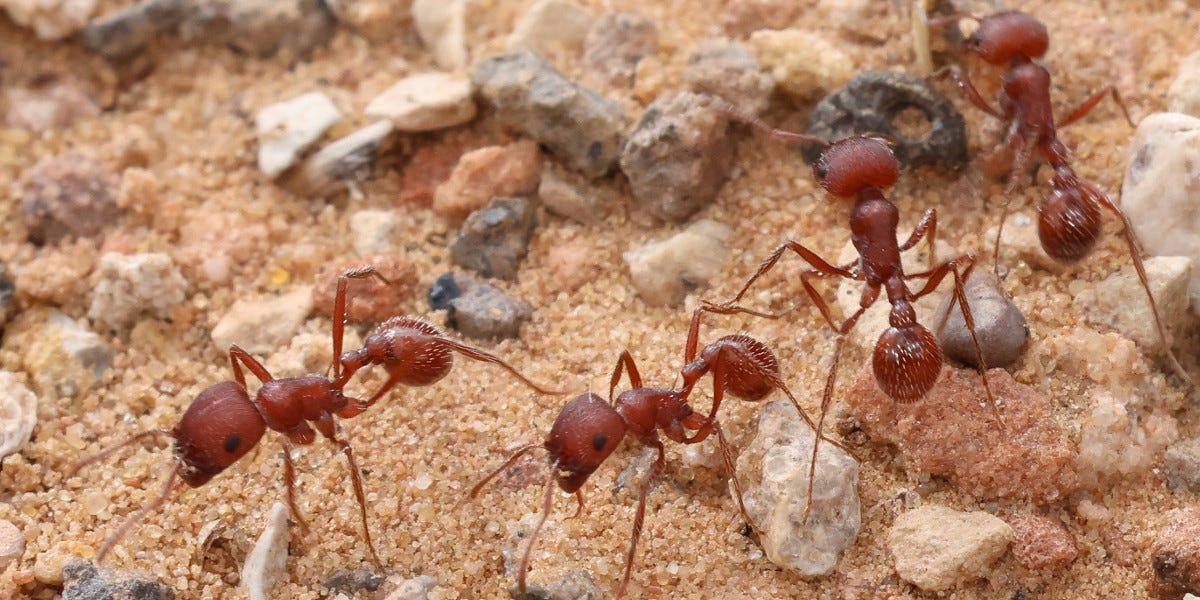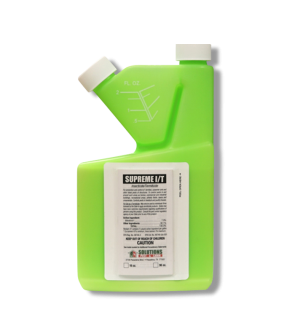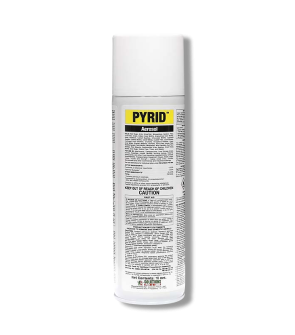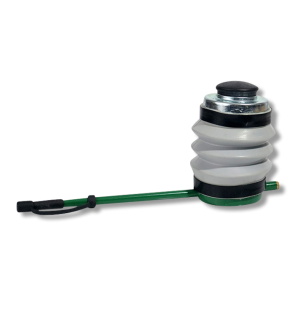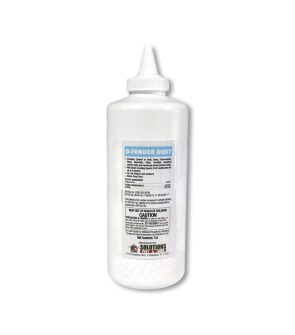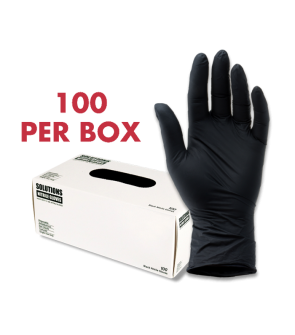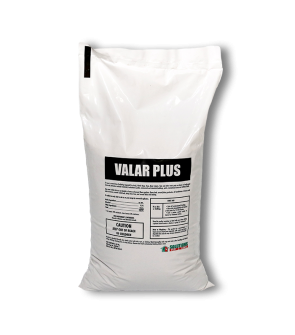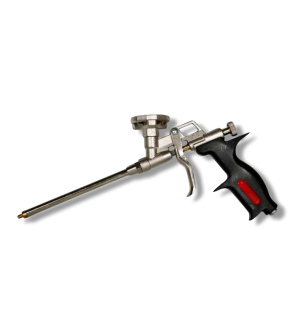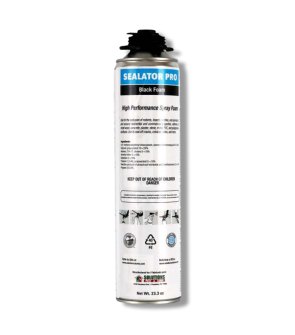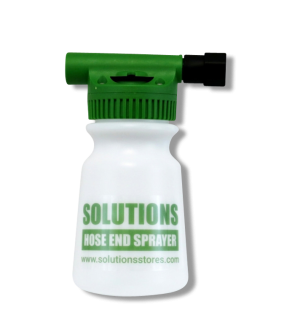Gain access to personalized product screening, the best pricing, rewards, and more!
Most Effective Products
Harvester Ant Control: How to Get Rid of Harvester Ants
This page is a general harvester ant control guide. Using the products and methods suggested, you will get control of harvester ants. Follow this guide and use the recommended products; we guarantee 100% control of harvester ants.
Harvester ants, also known as agricultural ants, occur throughout the United States and can quickly make itself known once present. These ant creates large, sandy mounds that appear suddenly in yards and gardens, often catching homeowners by surprise.
Besides clearing large patches of vegetation around their nests, they actively harvest seeds, which can damage grass, plants, and even crops. Additionally, these ant mounds can create uneven landscapes that not only complicate mowing, increase the chances of tripping, but also contribute to possible soil erosion.
On top of that, harvester ants are known for their painful stings, which can last for several hours. This can be very concerning if you have pets or kids or frequently use your yard. Given these issues, understanding how to effectively control and prevent harvest ants with the tips and products in our DIY guide is important for protecting yourself, your family, pets, and your property.
Identification
Before conducting harvester ant control, you will need to ensure the infestation is harvester ants and not other ant species. Misidentification can lead to using the wrong treatment methods, costing you time and money. There are up to 22 species of harvester ants throughout the United States, so we will go over common characteristics to properly identify these ants:
- Harvester ants are relatively large ants that measure 1/4 to 1/2 inches long. They are usually orange to reddish brown to dark brown or black in color with six legs and a twelve-segmented clubless antennae.
- Their bodies are divided into three distinct segments: the head, thorax, and abdomen. The midsection features a two-segmented waist with one pair of spines on top in most species, while many have long hairs on their heads that form a sort of beard. The heads of harvester ants are generally a blockish square in shape. Depending on the species, they may or may not have spines on their bodies.
- A key feature of harvester ants is their powerful mandibles, which they use to cut and collect seeds.
- Adult harvester ants have four clear wings with amber-colored veins during mating season. These winged ants leave the nest to mate and start new colonies. Outside this time, workers are usually wingless.
Use the image and description above to help you correctly identify harvester ants in your lawn. If you are not entirely sure, contact us by phone, email, or in person at one of our store locations for a photo of your pest so we can assist you with proper identification. A pest sample may be brought as long as it's in a sealable plastic container.
Inspection
After harvester ants have been properly identified, you can proceed with inspection. During this step, you will locate sites of harvester ant infestations and the conditions allowing the ants to thrive. This will help you determine where to focus pesticide applications and avoid unnecessary product usage.
Where to Inspect
Harvester ants mainly create their nests outdoors in environments that are dry, sunny, open, little to bare vegetation, and have sandy and loose soil.
You will find harvester ant nests in lawns, grasslands, desert areas, open woodlands, gardens, agricultural fields, edges of driveways and sidewalks, playgrounds, near bird feeders, and other areas with open spaces and little amounts of foliage.
While these ants may nest near residential areas, they do not create nests indoors or invade structures often.
It is very rare to see harvester ants indoors foraging for food, and if you do it's safe to assume there is no indoor infestation. Sometimes they may accidently enter a home through cracks and crevices around windows and doors.
What to Look For
One of the most noticeable signs of harvester ants is their mounds.
These ants clear large, circular patches of vegetation around their nests, often leaving bare soil areas that reach up to 12 feet in diameter and nests that reach 3 feet deep. At the center of this cleared zone, you will find one to three small entrance holes leading into the nest.
The entrances are sometimes surrounded by low, flat mounds made of fine sand, gravel, or soil that the ants have digged up from their deep underground tunnels.
In some cases, the mound surface is scattered with small pebbles, charcoal fragments, or dried plant material.
Another telltale sign is the presence of narrow, worn trails leading away from the nest. These paths are often lined with discarded seed husks, as harvester ants forage and carry food back to their colony.
Treatment
Before proceeding with harvester ant control, you will need to wear the proper personal protective equipment (PPE) such as a long-sleeved shirt, gloves, mask, safety glasses, coveralls or tyvek suit, and closed-toe shoes with socks.
If your dealing with harvester ants on your property, you need a solid multi-step approach that targets the entire colony not just the individual worker ants you see.
Flagging harvester ant mounds with small, visible markers such as garden flags, stakes, or brightly colored tape can help you avoid accidentally disturbing or damaging the mounds before treatment. Disturbing ant mounds prematurely can cause these pests to relocate or split their colony, making control much harder.
Step 1: Apply Granular Insecticide Across Property

Valar Plus Bifenthrin Granules is a powerful bifenthrin-based granule insecticide that's effective against a broad range of pests, including ants in lawns, landscape areas, and the exterior perimeters of listed structures.
Determine how much Valar Plus Bifenthrin Granules to use by measuring the square footage of the treatment area. Find the square footage by measuring the treatment area's length and width in feet, then multiplying them together (length X width = square footage). For acreage, take the square footage and divide it by one acre (square footage / 43,560 sq. ft. = acres).
To control ants, apply 2.3 to 4.6 pounds of Valar Plus Bifenthrin Granules per 1,000 sq. ft.
To spread the granules you will need a push spreader, or broadcast spreader. For smaller treatment areas, you may need a handheld spreader.
Calibrate your spreader to the proper settings, then load the proper amount of product.
Walk your lawn in a back-and-forth pattern in rows to spread the granules evenly. Overlap slightly on each pass to avoid untreated gaps.
After applying the granules, irrigate the treated area with 0.25 inches of water. We recommend watering it in with an insecticide like Supreme IT.
By performing this action, you not only activate the granules but also increase control over harvester ants.
Step 2: Apply Supreme IT

Supreme IT is a powerful, long-lasting insecticide concentrate that treats up to 70 types of pests and continues to protect treated sites for up to 90 days after application.
This product will need to be mixed with water in a handheld pump sprayer or hose-end sprayer. Best to use a handheld pump sprayer when treating ant mounds.
First, spray Supreme IT evenly over your entire lawn and sites where Valar Plus was applied.
To control ants in lawns and ornamentals, mix 0.5 to 1.0 fl. oz. of Supreme IT per 1 gallon of water per 1,000 sq. ft.
Spray the top and bottom of foliage leaves until wet, but not to the point of runoff.
For harvester ant nests, you will need to use a 0.06% dilution. To achieve this dilution, use 1 oz. of product with 1 gallon of water.
Use 1 to 2 gallons of dilution for each mound area.
Apply Supreme IT by sprinkling the solution over the harvester ant mound until the area is thoroughly wet. Be sure to treat a 4-foot diameter circle around the mound to target foraging ants.
For larger mounds those over 12 inches in diameter, increase the volume of solution to ensure deep penetration and effective coverage.
This application technique drives Supreme IT deep into the colony, helping eliminate ants at the source, including the queen.
Best to make applications in late evening or early morning when temperatures are between 60 to 80 degrees Fahrenheit when ants are most active.
Keep people and pets away from the treated area until the spray has completley dried.
Step 3: Treat Voids and Crevices with D-Fender Dust

D-Fender Dust Insecticide is a lightweight, waterproof insecticide dust that provides powerful protection against a broad range of pests indoors and outdoors. It can create an 8-month residual against pests if left undisturbed.
To dust easily in cracks and crevices, we suggest using a handheld duster, or bulbous duster.
For indoor use, apply 1 oz. of D-Fender Dust Insecticide per 125 sq. ft. or 1/2 lb. of product per 1,000 sq. ft.
Apply D-Fender Dust thoroughly to all areas where pests crawl and hide, paying close attention to cracks, crevices, voids, and other concealed spaces where insects may live or breed.
Focus the application on ant trails, around doors and windows, and in other areas where ants are entering or commonly seen within the premises. Be sure to also treat plumbing lines, along baseboards, water and sewer pipes, and beneath and behind cabinets, refrigerators, and sinks.
For a residual treatment, apply the dust around windows and doors, along porches, patios, screens, and eaves, and in garages, under stairways, and inside crawl spaces, any location where ants are active or may find entry into the structure.
Apply the dust lightly and evenly to ensure effective coverage without over-application or visible residue, especially in living areas.
Repeat after 10 days only if needed to maintain control.
Do not apply more than 2 times per year for indoor and outdoor treatments.
Step 4: Spot Treat with Pyrid Insecticide Aerosol

Pyrid Insecticide Aerosol is a fast-acting contact insecticide spray that quickly eliminates a wide range of flying and crawling pests both indoors and outdoors.
Hold the aerosol can about 18 to 24 inches from the ants and spray directly on them using a short burst. Allow the spray to drift to the area being treated, and ensure the white actuator is installed.
The amount of product applied is not to exceed 10 seconds per room for residential areas or 10 seconds per 100 sq. ft. for commercial areas.
If you want to flush ants out from cracks, crevices, or voids, then attach the red actuator and install the straw after for a more precise, targeted spray.
But for general contact kill on open surfaces, the straw is unnecessary.
To use as a crack and crevice treatment, place the injector tip into cracks, crevices, holes, and other small openings where you have seen the ants. Apply the product for 1 second.
For light infestations, move the injector tip along cracks while treating at the rate of 3 feet per second.
For heavy infestations, move the injector tip along at the rate of 1-feet per second.
Do not allow the spray to contact plastic, painted, or varnished surfaces or directly into electronic equipment such as radios, TV's, computers, etc.
Prevention

- To prevent harvester ants, we recommend applying a long-lasting residual insecticide like Supreme IT around the perimeter of your home and lawn every 90 days. For general prevention, mix 1 fl. oz. of Supreme IT per 1 gallon of water per 1,000 sq. ft. Apply Supreme IT to the entire lawn, flower beds, and around building foundations, especially where harvester ants previously built mounds. To create a perimeter treatment, spray 3 feet up the foundation and 6 to 10 feet out from the structure. Be sure to also spray around window and door frames, plumbing penetrations, eaves, soffits, cracks, crevices, and other voids.
- Next, broadcasting Valar Plus Bifenthrin Granules across your property 2 to 3 times per year can help prevent colonies from forming beneath the turf's soil. One application of this product will last 2 to 3 months, so we recommend making applications during the spring, mid-summer, and fall for best coverage.
- Good property maintenance also plays a critical role in harvester ant prevention. These ants are attracted to open, undisturbed soil and areas with abundant seeds, so it's important to keep your yard clean, mowed, and free of debris. Rake up fallen leaves, seed pods, and other plant debris, and clean up birdseed and pet food. Store seeds and foods in airtight plastic containers with tight-fitted lids to block their access and limit attractants.
- Since harvester ants prefer areas with less vegetation, we suggest reseeding bare patches of lawn and maintaining regular fertilization to encourage thick turf growth.
- Avoid overwatering your lawn. While harvester ants prefer dry soil, excessive moisture can sometimes drive them to build their nests closer to structures or into shaded areas. We recommend watering with no more than 1 inch of irrigation once per week, preferably in the early morning.
- Sealing entry points around your home can help prevent the ants from entering when foraging. Use caulk or foam sealant such as Solutions Sealator Pro to seal cracks and crevices in foundations, around windows, door frames, and utility penetrations. Pay close attention to areas near the ground where ant trails are often established. Replace weather stripping around door frames if needed.
Key Takeaways
What are Harvester Ants?
- Harvester ants are a type of ant known for collecting and storing seeds as their primary food source, often building large colonies underground.
How to Get Rid of Harvester Ants
- To get rid of harvester ants, start by spreading Valar Plus Bifenthrin Granules across your lawn. Follow up with a spray of Supreme IT over the entire yard, ornamentals, and directly onto mounds to penetrate and eliminate colonies at the source. For added protection, apply D-Fender Dust in cracks, crevices, and entry points, and use Pyrid Insecticide Aerosol for quick knockdown of visible ants indoors or around your home.
Preventing Harvester Ant Reinfestations
- To prevent harvester ants, apply Supreme IT around your home's perimeter every 90 days and broadcast Valar Plus Bifenthrin Granules across your lawn every 2 to 3 months. Maintain a clean, well-kept yard by removing debris, sealing cracks, and storing seeds and food in airtight containers. Promote dense turf growth by reseeding bare patches and avoid overwatering to discourage nesting.






